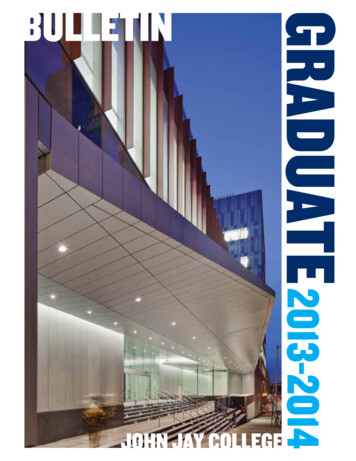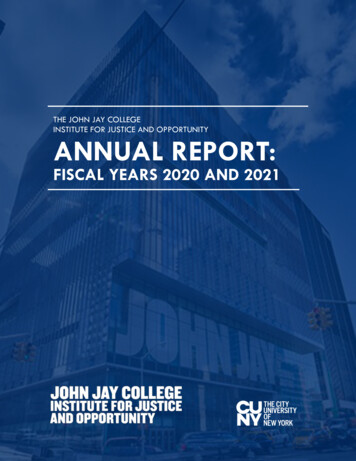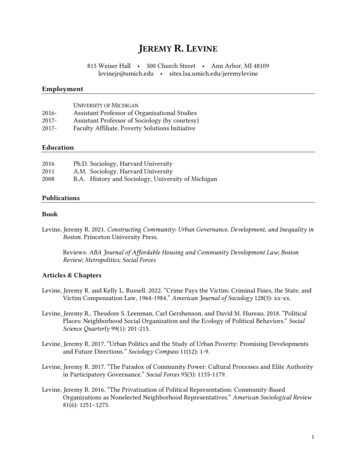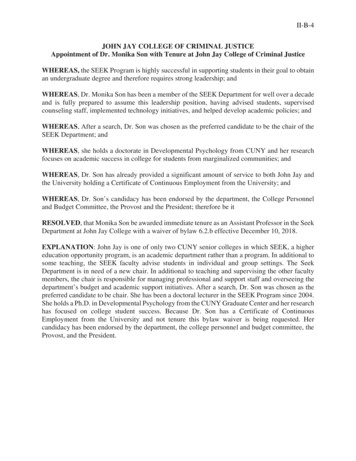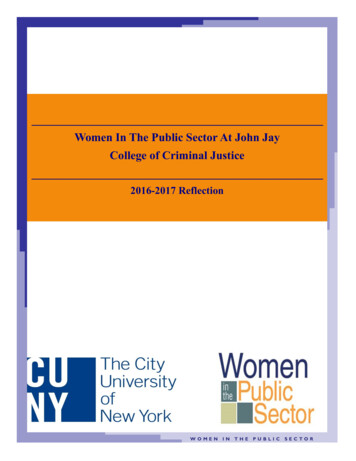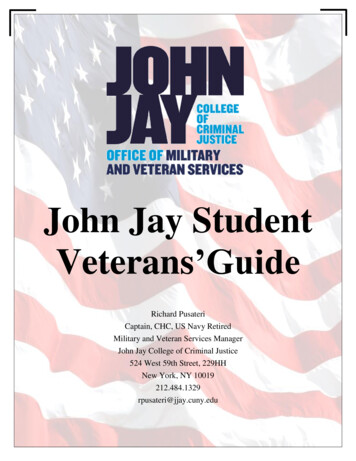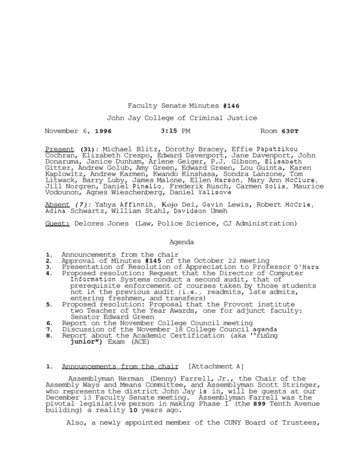
Transcription
JEREMY TRAVISPresidentJohn Jay College of Criminal Justice524 West 59th StreetNew York, NY 2Member of New York University Law Review. Author of Note, RethinkingSovereign Immunity After Bivens, 57 N.Y.U.L. Rev. 597 (1982). Recipient ofJohn Norton Pomeroy Prize for academic achievement. Recipient of ArthurGarfield Hays Fellowship in Civil Liberties. New York University School ofLaw: J.D., cum laude. Elected to Order of the Coif.1977New York University Wagner Graduate School of Public Service: M.P.A.Studied public policy analysis, public sector management, and evaluationresearch.1970Yale College: B.A., cum laude, in American Studies, with interdisciplinaryconcentration in African-American studies. Recipient of the C. Douglas GreenMemorial Prize in History for senior thesis on nineteenth century AfricanAmerican intellectual history. Recipient of Saybrook Fellows Prize.EMPLOYMENT HISTORYPresident, John Jay College of Criminal Justice (CUNY): 2004 to present.Under his leadership, John Jay College: Was transformed into a senior college offering a rigorous undergraduate liberal artsprogram. Joined the prestigious Macaulay Honors College of CUNY. Increased freshman enrollment by half and full time faculty by one third. Tripled its external funding for faculty research. Expanded its masters programs to eleven and now houses two nationally recognizeddoctoral programs. Launched John Jay Online and completed its first capital campaign for 50 million.Senior Fellow, The Urban Institute, Justice Policy Center: 2000 to 2004. Senior Fellow at theUrban Institute, a nonpartisan research and policy organization. Affiliated with the new JusticePolicy Center created by the Institute to develop research on issues of safety, crime and theadministration of justice. Specifically: Raised approximately 18 million to launch a national program of research andpolicy development on the issue of prisoner reentry. Led the design of Returning Home: Understanding the Challenges of PrisonerReentry, the first multi-state longitudinal study of prisoner reentry.
Created the Reentry Roundtable, a group of nationally prominent researchers, policymakers, practitioners, community leaders and former prisoners dedicated todeveloping new thinking on sentencing, incarceration, and reentry.Convened forum at the National Press Club to develop better understanding of therecent crime decline in America.Developed an initiative with the Harvard Civil Rights Project to explore the nexusbetween race, crime, communities and civil rights.Under grant from Department of State, worked with police executives, scholars, andcommunity representatives from the U.S. and Northern Ireland to promote policereforms in Northern Ireland following the Good Friday accords.Participated in academic workshops in South Africa, Italy, and the United Kingdomon comparative perspectives on crime control policy, policing reform, prisonerreintegration, and crime measurement.Created interdisciplinary, cross-Center committees on (1) research on youthdevelopment and (2) research on crime and justice in the District of Columbia.Director, National Institute of Justice, Department of Justice: 1994-2000. Nominated byPresident Clinton and confirmed by the U.S. Senate to serve as Director of the National Instituteof Justice, the research arm of the Department of Justice. Managed growth of NIJ from an annualbudget of 25 million to 120 million, and from 40 employees to 120 employees. Created abroad scientific agenda including national evaluations of federal crime initiatives, longitudinalstudies of the nexus between community capacity and criminal behavior, programmaticevaluations of anti-crime interventions, advancement of DNA and other forensic sciences,development of law enforcement technologies, and research on counter-terrorism strategies.Created the Arrestee Drug Abuse Monitoring (ADAM) program, a national researchinfrastructure to assess crime patterns, track trends in drug use, and support local crime controlstrategies. Established the NIJ International Center to support comparative research and studytransnational crime. Forged partnerships with other federal research institutes, internationalresearch centers, and federal agencies including the departments of Defense, Treasury, Health andHuman Services, Education, and Housing and Urban Development.Deputy Commissioner, Legal Matters, New York City Police Department: 1990-1994. Served asGeneral Counsel to the Police Department, advisor to Police Commissioners Brown, Kelly andBratton, and member of the Department’s Executive Staff. Oversaw three departmental units: theLegal Bureau, a 100- person unit that provides legal services to the Department on all criminaland civil matters; the License Division, a 200- person unit that administers pistol and firearmlicenses in New York City; the Criminal Justice Bureau, a 1400- person unit that serves as liaisonbetween the Police Department and the agencies of New York City’s criminal justice system.Created the Civil Enforcement Initiative, a program that combined civil and criminal remedies toaddress local crime conditions. This initiative received the Innovations in Government Award in1995 from the Ford Foundation and Kennedy School of Government. Drafted legislation banningassault rifles and oversaw its implementation. Instituted a system of performance indicators totrack the arrest to arraignment process, bringing average times from 42 hours to less than 24hours and saving millions of dollars in new arrest overtime. At the request of Schools ChancellorJoseph Fernandez, chaired a Panel on School Safety (with Dr. Gerald Lynch and Prof. EllenSchall) that recommended structural reforms in the Board of Education’s approach to schoolsafety.2
Chief Counsel, Subcommittee on Criminal Justice of the House of Representatives Committee onthe Judiciary: 1990. As Chief Counsel to Subcommittee chaired by Rep. Charles E. Schumer,developed new agenda for oversight hearings and legislative initiatives on criminal justice issues.Special Advisor to the Mayor, City of New York: 1986-1989. Generally, advised Mayor EdwardI. Koch and members of mayoral staff on emerging issues on a daily basis, acted as Mayor’sliaison to city agencies, prepared position papers, drafted articles and undertook special projects.Specifically: conducted management and legal review of the City Human Rights Commission;served as Mayor’s liaison to the Charter Revision Commission and chaired Interagency CharterRevision Working Group; coordinated City’s implementation of federal immigration legalizationprogram; developed recruitment and training programs (Mayor’s Corps of Engineers, LaGuardiaFellowship Program); coordinated City’s response to Commission on Hispanic Concerns andCommission on Black New Yorkers; formed Commission to establish the High School Institutefor Law and Justice at the Martin Luther King, Jr. High School; established Mayor’s AdvisoryCouncil on Community Relations following the racial attack in Howard Beach; establishedPublic/Private School Partnership; served on Chancellor’s Steering Committee on UniversityCollaboratives. As interim Coordinator of the Mayor’s Office of Educational Services,established the Commission on Early Childhood Education; was responsible for Project GiantStep and the Adult Literacy Initiative; and served as Mayor’s liaison to the Board of Educationand the City University of New York.Special Counsel to the First Deputy Mayor and Assistant Director for Law Enforcement Services,Mayor’s Office of Operations: 1986. On staff of First Deputy Mayor Stanley Brezenoff, withoversight responsibilities for Departments of Police, Corrections, Probation, Sanitation, Fire,Consumer Affairs, and Juvenile Justice. Acted as representative of First Deputy Mayor inassessing, developing and implementing City policy in these agencies.Special Counsel to the Police Commissioner, New York City Police Department: 1984-1986.Served as legal and general policy advisor to Police Commissioner Benjamin Ward. Developednew recruitment program, the Police Cadet Corps, a successful mayoral initiative to attract morecollege-educated, highly-motivated, and racially diverse candidates as police officers. Developedpolicy recommendations and research agenda for the Civilian Complaint Review Board. Acted asliaison to mayoral Commission on Police Management and Personnel Policy, chaired by JohnZuccotti. Acted as general advisor on policy matters, representing the Police Commissioner ashis liaison to City Hall, City Council, other agencies, and parties to litigation. Generally servedas writer and editor of Commissioner’s prepared remarks and other written communications.Law Clerk to Judge Ruth Bader Ginsburg: U.S. Court of Appeals for the District of ColumbiaCircuit: 1982-1983.Consultant, New York City Board of Correction: 1979-1982. Consulted on development ofclassification systems for pretrial detainees.Executive Director, New York City Criminal Justice Agency: 1977-1979. Director of 200employee, citywide public benefit corporation under 3.5 million contract with New York City toconduct criminal justice research, develop experimental programs, and provide information toassist in pretrial decision-making.Executive Director, Victim/Witness Assistance Project to the Vera Institute of Justice: 19751977. Director of 1 million federal demonstration project providing services to crime victims3
and prosecution witnesses and conducting research on the victim’s role in the criminal justicesystem.Pretrial Services Agency of the Vera Institute of Justice: 1973-1975. Held a variety ofmanagement and supervisory positions in agency conducting criminal justice research andpromoting bail reform.Legal Services Assistant, Legal Aid Society: 1971-1973. Prepared cases for attorneys defendingthe indigent in criminal prosecutions in the Manhattan and Bronx Criminal Courts.LAW SCHOOL EMPLOYMENT AND FELLOWSHIPSHays Fellow, American Civil Liberties Union, Women’s Rights Project: Spring 1982.Researched relationship between McCarran-Ferguson Act, ERISA, and Title VII for genderdiscrimination litigation.Hays Fellow, NAACP Legal Defense and Education Fund: Fall 1981. Worked on Title VII racediscrimination litigation against the City of New Orleans Police Department and the Gulf OilCorporation.Summer Associate, Cravath, Swaine & Moore: Summer 1981. Worked on census litigation, firstamendment challenge to federal anti-counterfeiting statute, Supreme Court brief on Title VII andres judicata issues, and international commercial litigation.Summer Intern, American Civil Liberties Union: Summer 1980. Researched wrongful deathaction under Federal Tort Claims Act against FBI for its involvement in 1965 death of civil rightsworker Viola Liuzzo.FACULTY APPOINTMENTS AND FELLOWSHIPSProfessor, John Jay College of Criminal Justice, Department of Law, Police Science and CriminalJustice Administration: 2004-2008. Taught graduate and undergraduate classes on prisonerreentry.Member of Doctoral Faculty in the Criminal Justice Doctoral Program, City University of NewYork, Graduate Center: 2004-present.Visiting Professor, George Washington University: Spring 2004. Taught graduate seminar inDepartment of Sociology on the challenges of prisoner reintegration.Adjunct Associate Professor, New York Law School: 1992-1994. Taught courses on legal andpolicy issues facing the criminal justice system.Adjunct Professor, New York University Wagner Graduate School of Public Service: 1985-1990.Taught course entitled “Administration of Criminal Justice in New York City” to graduatestudents of public administration.Marden and Marshall Fellow in Criminal Law, New York University School of Law: 1983-1984.As Research Fellow at the NYU Center for Research in Crime and Justice conducted research on4
crime victims and the enforcement of the draft registration law. Co-authored article on selectiveprosecution.Visiting Lecturer, Political Science Department, Yale College: 1979. Taught undergraduateseminar, “Policy Issues in the Criminal Justice System.”Instructor, History Department, Yale College: 1971. Taught undergraduate African-Americanhistory course.Rockefeller Fellow, Yale Divinity School: 1970-1971. Recipient of one-year fellowship fromRockefeller Foundation for theological education. Studied nineteenth century reform movements.PUBLICATIONSBooksTravis, J., Western, B., Redburn, S. (Eds.) (2014). The Growth of Incarceration in the UnitedStates: Exploring Causes and Consequences. Washington, D.C.: The National Academies Press.Travis, J. (2005). But They All Come Back: Facing the Challenges of Prisoner Reentry.Washington, D.C.: Urban Institute Press.Travis, J., Visher, C. (Eds.) (2005). Prisoner Reentry and Crime in America. New York:Cambridge University Press.Travis, J., Waul, M. (Eds.) (2003). Prisoners Once Removed: The Effect of Incarceration andReentry on Children, Families, and Communities. Washington, D.C.: Urban Institute Press.Book Chapters and ForewordsTravis, J. (2015). A culture change. In: Inimai Chettiar and Michael Waldman (Eds.). Solutions:American leaders speak out on criminal justice. Brennan Center for Justice at New YorkUniversity of Law.Visher, C., Travis, J. (2012). The Characteristics of Prisoners Returning Home. In: JoanPetersilia, Kevin Reitz (Eds.). The Oxford Handbook of Sentencing and Corrections. New York:Oxford University Press.Travis, J. (2011). Foreword. In: Mangai Natarajan (Ed.). International Crime and Justice.Cambridge: Cambridge University Press.Travis, J., Crayton, A. (2009). Offender Reentry. In: J. Mitchell Miller (Ed.). 21st CenturyCriminology: A Reference Handbook, Vol.2. Washington D.C.: Sage Publications.Travis, J., Visher, C. (2005). Prisoner Reentry and the Pathways to Adulthood: PolicyPerspectives. In: D. Wayne Osgood, E. Michael Foster, Constance Flanagan & Gretchen R. Ruth(Eds.). On Your Own Without a Net: The Transition to Adulthood for Vulnerable Populations.Chicago: University of Chicago Press.5
Travis, J. (2004). Building Safe and Just Communities from the Ground Up. In: E. H. Judah &Rev. M. Bryant (Eds.). Criminal Justice: Retribution vs. Restoration. Binghamton, NY: HarworthPressTravis, J. (2004). Reentry and Reintegration: New Perspectives on the Challenges of MassIncarceration. In: M. Pattillo, D. Weiman, & B. Western. Imprisoning America: The SocialEffects of Mass Incarceration. New York: Russell Sage.Travis, J. (2003). Invisible Punishment: An Instrument of Social Exclusion. In: M. Mauer & M.Chesney-Lind (Eds.). Invisible Punishment: The Collateral Consequences of Mass Imprisonment(1-36). New York: The New Press.Journal ArticlesTravis, J. (2016). Mass Incarceration in America: Can it be reversed? Advancing CorrectionsJournal, 2, pp. 18-22.Travis, J., Western, B. (2015). Reflections on the NAS Report on High Rates of Incarceration inthe United States. The Criminologist, 40(3), pp. 1-7.Kazemian, L., Travis, J. (2015). Forgotten prisoners: Imperative for inclusion of long termers andlifers in research and policy. Criminology & Public Policy, 14(2), pp. 1-41.Travis, J. (2014). Assessing the state of mass incarceration: Tipping point or the new normal?Criminology & Public Policy, 13(4), pp. 567-577.Travis, J. (2011). Les Sortants de Prison et la Sécurité Publique: Faire Face Au Défi de laRéinsertion des Détenus. AJ Pénal, septembre 2011, no9, pages 377 a 428.Visher, C., Travis, J. (2011). Life on the outside: returning home after incarceration. The PrisonJournal, Vol. 91 (3 suppl), pp. 102S-119S.Travis, J., Crayton, A., Mukamal, D. (2009). A New Era in Inmate Reentry. Corrections Today,Vol. 71 (6), pp. 38-41.Travis, J. (2007). Reflections on the Reentry Movement. Federal Sentencing Reporter, Vol. 20(2), pp. 1-4.Travis, J. (2007). Back-end sentencing: A practice in search of a rationale. Social Research, Vol.74(2), pp. 631-644.Travis, J., Christiansen, K. (2006). Failed reentry: The challenges of back-end sentencing.Georgetown Journal on Poverty, Law & Policy, Vol. 13(2), pp. 249-260.Travis, J. (2006). Defining a research agenda on women and justice in the age of massincarceration. Women & Criminal Justice, Vol. 17(2/3), pp. 127-136.Travis, J., Gouvis Roman, C. (2006). Where will I sleep tomorrow? Housing, homelessness, andthe returning prisoner. Housing Policy Debate, Vol. 17(2), pp. 389-418.6
Travis, J., Sommers, A. (2004). Preface, Journal of Correctional Healthcare, Vol. 10(3), pp. 281286.Travis, J. (2004). Building safe and just communities from the ground up. Journal of Religionand Spirituality in Social Work: Social Thought, Vol. 23(1/2).Mears, D., Travis, J. (2004). Youth development and reentry. Youth Violence and JuvenileJustice, Vol. 2(1).Travis, J., Visher, C. (2003). Transitions from prison to community: Understanding individualpathways. Annual Review of Sociology, Vol. 29, pp. 89-113.Travis, J., Robinson, L, Solomon, L. (2002). Prisoner reentry: Issues for practice and policy.Criminal Justice 17(1), pp. 12-18.Travis, J., Lawrence, S. (2002). California’s parole experiment. California Journal, Vol. 33(8),pp. 18-23.Travis, J., Petersilia, J. (2001). Reentry reconsidered: A new look at an old question. Crime andDelinquency 47(3), pp. 291.Travis, J. (2001). But they all come back: Rethinking prisoner reentry. Corrections ManagementQuarterly, Vol. 5(3), pp. 23-33.Travis, J. (2001). The challenge of prisoner release: The case of the District of Columbia and itsimplications for other jurisdictions. Offender Programs Report: Social and BehavioralRehabilitation in Prisons, Jails and the Community, Vol. 5(4).Travis, J. (2001). International strategies for crime prevention in transitional societies: Problemsand prospects. Crime and Policing in Transitional Societies, Vol, 8, pp. 229-234.Travis, J., Robinson, L. (2000). Managing prisoner reentry for public safety. Federal SentencingReporter, Vol. 12(5), pp. 258-265.Travis, J. (2000). Prisons, work and re-entry. Corrections Today, Vol. 61(6), pp. 102-105.Travis, J. (2000). New challenges in evaluating our sentencing policy: Exploring the public safetynexus. Corrections Compendium.Travis, J. (1999). Policing in transition. Police Practice and Research, Vol. 1(1), pp. 31-39.Travis, J. (1998). Declining crime and our national research agenda: A New Yorker’s view.Security Journal, Vol. 12(3), pp. 145-150.Travis, J., Smarrito, W. (1992). A modest proposal to end gun running in America. FordhamUrban Law Journal, Vol. 19(4), pp. 795.Jacobs, J., Travis, J. (1985). Compliance strategies for draft registration. Arizona Law Review,Vol. 27, pp. 837.7
Travis, J. (1982). Rethinking sovereign immunity after Bivens. New York University Law Review,Vol. 57, pp. 597.Reports and Newspaper ArticlesPreeti Chauhan, Megan Welsh, Adam G. Fera, Ervin Balazon with an introduction by JeremyTravis. 2015. The summons Report: Trends in the Issuance and Dispositions of Summonses inNew York City, 2003-2013. Report presented to the Citizens Crime Commission in New York onApril 27, 2015. City University of New York: John Jay College of Criminal Justice.Preeti Chauhan, Adam G. Fera, Megan Welsh, Ervin Balazon Evan Misshula with an introductionby Jeremy Travis. 2014. Trends in misdemeanor arrest rates in New York. Report presented tothe Citizens Crime Commission in New York on October 28, 2014. City University of New York:John Jay College of Criminal Justice.Jeremy Travis, Ronald Davis, Sarah Lawrence 2012. Exploring the Role of the Police in PrisonerReentry. Harvard: Harvard Kennedy School of Government.Christopher Stone, Jeremy Travis. 2011. Toward a New Professionalism in Policing. Harvard:Harvard Kennedy School of Government.Jeremy Travis. 2007. Watch and release. The New York Times, Op-Ed Contributor, Section14CY, Column 0, p. 11.Karen Beckman, Kelly Dedel Johnson, Amy L. Solomon, Jeremy Travis. 2004. Prisoner Reentryand Community Policing: Strategies for Enhancing Public Safety. Washington, D.C.: UrbanInstitute Press.Amy L. Solomon, Kelly Dedel Johnson, Jeremy Travis, Elizabeth Cincotta McBride. 2004. FromPrison to Work: The Employment Dimensions of Prisoner Reentry. Washington, D.C.: UrbanInstitute Press.Sarah Lawrence, Jeremy Travis. 2004. The New Landscape of Imprisonment: Mapping America’sPrison Expansion. Washington, D.C.: Urban Press.Jamie Watson, Amy L. Solomon, Nancy G. LaVigne, Jeremy Travis, Meagan Funches, BarbaraParthasarathy. 2004. A Portrait of Prisoner Reentry in Texas. Washington, D.C.: Urban InstitutePress.Caterina Gouvis Roman, Jeremy Travis. 2004. Taking Stock: Housing, Homelessness, andPrisoner Reentry. Washington, D.C.: Urban Institute Press.Daniel P. Mears, Jeremy Travis. 2004. The Dimensions, Pathways, and Consequences of YouthReentry. Washington, D.C.: Urban Institute Press.Amy L. Solomon, Michelle Waul, Asheley Van Ness, Jeremy Travis. 2004. Outside the Walls: ANational Snapshot of Community-Based Prisoner Reentry Programs. Washington, D.C.: UrbanInstitute Press.8
Christy Visher, Nancy G. LaVigne, Jeremy Travis. 2004. Returning Home: Understanding theChallenges of Prisoner Reentry: Maryland Pilot Study: Findings from Baltimore. Washington,D.C.: Urban Institute Press.Jeremy Travis, Sinead Keegan, Eric Cadora. 2003. A Portrait of Prisoner Reentry in New Jersey.Washington, D.C.: Urban Institute Press.Nancy G. LaVigne, Cynthia A. Mamalian, Jeremy Travis, Christy Visher. 2003. A Portrait ofPrisoner Reentry in Illinois. Washington, D.C.: Urban Institute Press.Nancy G. LaVigne, Vera Kachnowski, Jeremy Travis, Rebecca Naser, Christy Visher. 2003. APortrait of Prisoner Reentry in Maryland. Washington, D.C.: Urban Institute Press.Daniel P. Mears, Gretchen E. Moore, Jeremy Travis, Laura Winterfield. 2003. Improving the LinkBetween Research and Drug Treatment in Correctional Settings. Washington, D.C.: UrbanInstitute Press.Jeremy Travis, Sarah Lawrence. 2002. Beyond the Prison Gates: The State of Parole in America.Washington, D.C.: Urban Institute Press.Jeremy Travis, Michelle Waul. 2002. Reflections on the Crime Decline in America: Lessons forthe Future? Washington, D.C.: Urban Institute Press.Sarah Lawrence, Daniel Mears, Glenn Dubin, Jeremy Travis. 2002. The Practice and Promise ofPrison Programming. Washington, D.C.: Urban Institute Press.Jeffrey Butts, Jeremy Travis. 2002. The Rise and Fall of Youth Violence in America. Washington,D.C.: Urban Institute Press.Michelle Waul, Jeremy Travis, Amy L. Solomon. 2002. Background paper: The Effect ofIncarceration and Reentry on Children, Families, and Communities. Washington, D.C.: UrbanInstitute Press.Jeffrey Butts, Mark Coggeshall, Caterina Gouvis, Daniel Mears, Jeremy Travis, Michelle Waul,Ruth White. 2002. Youth, Guns, and the Juvenile Justice System. Washington, DC: UrbanInstitute Press.Jeremy Travis, Amy L. Solomon, Michelle Waul. 2001. From Prison to Home: The Dimensionsand Consequences of Prisoner Reentry. Washington, D.C.: Urban Institute Press.Jeremy Travis. 2001. With Crime Down, Cops Face New Challenges. Law Enforcement News.Jeremy Travis, Amy L. Solomon. 2001. Building Knowledge on Prisoner Reentry. OhioDepartment of Corrections Reports.Jeremy Travis. 2001. Cops Cut Crime, Now They Must Build Trust. New York Daily News,Jeremy Travis. 2000. Policing Police Misconduct. New York Post, August 14, 2000.Jeremy Travis, 2000. But They All Come Back: Rethinking Prisoner Reentry. National Institute ofJustice.9
Jeremy Travis, Gerald Lynch, Ellen Schall. 1993. Rethinking School Safety. New York CityBoard of Education.Jeremy Travis, Thomas Doepfner. 1993. Using Subpoenas to Obtain Police Records. New YorkLaw Journal.LECTURES, SPEECHES AND TESTIMONYReducing Mass Incarceration: Exploring the Values of Values. Opening Address at the 2015National Forum on Criminal Justice in Atlanta, GA (2015).Community Justice: Viewing Mass Incarceration from the Ground Up. Keynote address at the 5thNational Conference on Community and Restorative Justice in Fort Lauderdale, FL (2015).What About the Children? Assessing the Ripple Effects of Mass Incarceration. Lecture deliveredat the Center for the Study of Race and Race Relations, Levin College of Law, University ofFlorida in Gainesville, FL (2015).The Growth of Incarceration in the United States. Presentation at the City University of NewYork (CUNY) School of Law in New York, NY (2015).Testimony before the Task Force on 21st Century Policing created by President Barack H.Obama. Panel on The Future of Community Policing, in Washington DC (2015).Reflections on the NAS Report: What Are the Prospects For Reducing the US Prison Population?Lecture delivered at the Hoffinger Colloquium of the Center for Research on Crime and Justice,New York University School of Law, in New York, NY (2015).Prisons First: Putting Prisons at the Center of the Criminal Justice Policy Debates. KeynoteAddress delivered at the Annual Meeting of the John Howard Association, in Chicago, IL (2014).Assessing the Burden of Crime and the Criminal Sanction: A Public Health Perspective onCritical Issues in Criminal Justice. Lecture delivered at The Dean's Seminar Series on thePrevention of Incarceration at the Mailman School of Public Health, Columbia University, inNew York, NY (2013).Assessing the Crime Decline: Did BIDs Play a Role? Master talk delivered at The InternationalDowntown Association 2013 World Congress in New York, NY (2013).Testimony before the National Association of Criminal Defense Lawyers Task Force onRestoration of Rights and Status After Conviction, Turning the Tide: Victories and Opportunitiesin Criminal Justice Reform, in New York, NY (2013).Restoring College Education to the Nation’s Prisons: Assessing the Prospects for Change.Keynote Address delivered at the conference on Education for All: Improving EducationalAccess in Correctional Facilities and Beyond at the United States Institute for Peace inWashington, DC (2013).10
Acceptance speech on occasion of the receipt of The Maud Booth Correctional Services Awardfrom the Volunteers of America in Denver, CO (2012).Understanding the Public Health Challenges in the Era of Mass Incarceration. Keynote Addressat the Fifth Annual Academic and Health Policy Conference on Correctional Health in Atlanta,GA (2012).Summoning the Superheroes: Harnessing Science and Passion to Create a More Effective andHumane Response to Crime. Keynote address delivered at the 25th Anniversary of the SentencingProject at the National Press Club in Washington, DC (2011).Youth, Race and the Justice System. Keynote address delivered at the New York City FamilyCourt and New York State Child Welfare Court Improvement Project conference in New York,NY Law School (2011).Reflections on Juvenile Justice Reform in New York. Keynote address delivered at the DianeAbbey Law Center for Children and Families conference in New York, NY Law School (2011).Rethinking Prison Education in the Era of Mass Incarceration. Keynote address delivered at theUniversity Faculty Senate Conference on Higher Education in the Prisons in New York, TheGraduate Center (2011).“What Works” for Successful Prisoner Reentry. Testimony before the United States House ofRepresentatives Committee on Appropriations Subcommittee on Commerce, Justice, Science, andRelated Agencies. Washington, D.C. (2009).Building Communities with Justice: Overcoming the Tyranny of the Funnel. Keynote addressdelivered at the Public Service Conference on the Future of Community Justice in Wisconsin,Marquette Law School, Milwaukee, Wisconsin (2009).Race, Crime and Justice: A Fresh Look At Old Questions. The New York City Bar Association2008 Orison S. Marden Lecture, New York, New York (2008).New Strategies for Combating Violent Crime: Drawing Lessons from Recent Experience.Testimony before the U.S. Senate Judiciary Committee, Washington DC (2008).School Safety and Emergency Response Planning. Testimony before the New York State SenateCommittee on Higher Education, Albany, New York (2007).The Penetration of the Criminal Justice System, Into Communities of Color: A LeadershipChallenge for the Legal Profession, New York State Judicial Institute on Professionalism in theLaw, Convocation on the Face of the Profession III:Leadership of the Bar, Albany, New York(2007).Rethinking the Fatherhood Agenda in the Context of the Era of Mass Incarceration. TheIndustrial Home for Children, Seventh Annual Fatherhood Conference “Fatherhood 2007: Fathersas the Missing Link”, East Windsor, New Jersey (2007).Responding to the Realities of The Era of Mass Incarceration In America. Public/PrivateVentures Conference, Houston, Texas (2006).11
Prisoner Reentry: National and Local Perspectives on a New Dialogue. Maryland ReentrySymposium, Annapolis, Maryland (2005).Prisoner Releases in the District of Columbia. United States House of RepresentativesCommittee on Government Operations, Subcommittee on the District of Columbia, Washington,D.C. (2001).Public Safety and the Criminal Sanction: Overcoming the Tyranny of the Funnel. AmericanSociety of Criminology, San Francisco (2000).International Strategies for Crime Prevention in Transitional Societies: Problems and Prospects.South African Institute of International Affairs, Johannesburg (2000).Building Knowledge About Crime and Justice in the Global Age: Infrastructure First. 5th BiennialConference of International Perspectives on Crime, Justice and Public Order, Bologna, Italy(2000).Public Health, Public Safety and Prisoner Reentry: Challenges of the Future. Second AnnualConference on Criminal Justice and Substance Abuse in New York State (2000).Alcohol and Crime: New Strategies for Crime Prevention. XII Alcohol Policy Conference,National Crime Prevention Council (2000).New Challenges in Evaluating our Sentencing Policy: Exploring the Public Safety Nexus.National Workshop on Sentencing and Corrections, Hilton Head, South Carolina (2000).Criminal Justice and Public Health: Opportunities Acr
Council on Community Relations following the racial attack in Howard Beach; established Public/Private School Partnership; served on Chancellor's Steering Committee on University Collaboratives. As interim Coordinator of the Mayor's Office of Educational Services, . Yale Divinity School: 1970-1971. Recipient of one-year fellowship from

